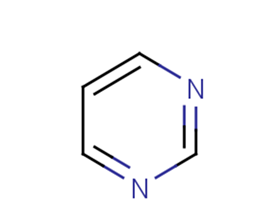
Pyrimidine
CAS No. 289-95-2
Pyrimidine( Metadiazine )
Catalog No. M19588 CAS No. 289-95-2
Pyrimidines are heterocyclic six-membered nitrogen-containing carbon ring structures with uracil cytosine and thymine being the basal structures of ribose-containing nucleosides (uridine cytidine and thymidine respectively) or deoxyribose-containing deoxynucleosides and their corresponding ribonucleotides or deoxyribonucleotides.
Purity : >98% (HPLC)
 COA
COA
 Datasheet
Datasheet
 HNMR
HNMR
 HPLC
HPLC
 MSDS
MSDS
 Handing Instructions
Handing Instructions
| Size | Price / USD | Stock | Quantity |
| 5MG | 49 | In Stock |


|
| 100MG | Get Quote | In Stock |


|
| 200MG | Get Quote | In Stock |


|
| 500MG | Get Quote | In Stock |


|
| 1G | Get Quote | In Stock |


|
Biological Information
-
Product NamePyrimidine
-
NoteResearch use only, not for human use.
-
Brief DescriptionPyrimidines are heterocyclic six-membered nitrogen-containing carbon ring structures with uracil cytosine and thymine being the basal structures of ribose-containing nucleosides (uridine cytidine and thymidine respectively) or deoxyribose-containing deoxynucleosides and their corresponding ribonucleotides or deoxyribonucleotides.
-
DescriptionPyrimidines are heterocyclic six-membered nitrogen-containing carbon ring structures with uracil cytosine and thymine being the basal structures of ribose-containing nucleosides (uridine cytidine and thymidine respectively) or deoxyribose-containing deoxynucleosides and their corresponding ribonucleotides or deoxyribonucleotides. Pyrimidines serve essential functions in human metabolism as ribonucleotide bases in RNA (uracil and cytosine) and as deoxyribonucleotide bases in DNA (cytosine and thymine) and are linked by phosphodiester bridges to purine nucleotides in double-stranded DNA in both the nucleus and the mitochondria. Pyrimidine activated sugars are also involved in polysaccharide and phospholipid synthesis glucuronidation in detoxification processes glycosylation of proteins and lipids and in the recently identified novel endothelium-derived vasoactive dinucleotides.
-
In Vitro——
-
In Vivo——
-
SynonymsMetadiazine
-
PathwayOthers
-
TargetOther Targets
-
RecptorOthers
-
Research Area——
-
Indication——
Chemical Information
-
CAS Number289-95-2
-
Formula Weight80.09
-
Molecular FormulaC4H4N2
-
Purity>98% (HPLC)
-
SolubilityDMSO:10 mM
-
SMILESc1cncnc1
-
Chemical Name13-Diazabenzene
Shipping & Storage Information
-
Storage(-20℃)
-
ShippingWith Ice Pack
-
Stability≥ 2 years
Reference
1.Loffler M et al. Pyrimidine pathways in health and disease. Trends Mol Med. 2005 Sep;11(9):430-7.
molnova catalog



related products
-
Harmaline
Harmaline is a fluorescent psychoactive indole alkaloid from the group of harmala alkaloids and beta-carbolines. It is the reduced hydrogenated form of harmine.
-
Ferrous fumarate
Iron(II) fumarate, also known as ferrous fumarate, is the iron(II) salt of fumaric acid, occurring as a reddish-orange powder, used to supplement iron intake.
-
Trastuzumab deruxtec...
Trastuzumab deruxtecan (T-DXd) is an antibody-active molecule conjugate (ADC) with anticancer and antitumor activity, which is composed of a monoclonal antibody targeting human epidermal growth factor receptor 2 (HER2) coupled to a topoisomerase I inhibitor (DXd).



 Cart
Cart
 sales@molnova.com
sales@molnova.com


